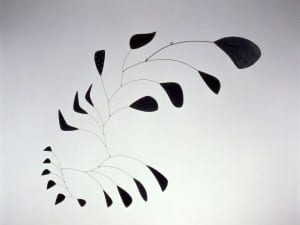Works of Alexander Calder and Fischli/Weiss, from the early and late-twentieth century, respectively, are now in dialogue, thanks to a recent Theodora Vischer’s project, Senior Curator at the Fondation Beyeler. In the entrance rooms, two figures (the size of children) lay on the floor. One in the costume of a black and white panda, the other, of a rat. Rat and Bear (Rat and Bear (Sleeping), 2008) look relaxed, absorbed by their own existence. Above them, a mobile is suspended from the ceiling by a thin wire, a composition of balances whose limbs end in numerous small, white metal discs. The composition’s centrepiece is a horizontal wire arm, held in suspension at its midpoint by the vertical wire. At one end of the arm is a metal disc that holds those at the other end in balance. These smaller discs fan out into ever-daintier pieces of the same shape and material. Even a slight draft is likely to make parts of the mobile quiver—a shiver that fortuitously spreads to the other components until, after they oscillate for a while, balance is restored (Snow Flurry, 1950).
Following the correspondence between this initial, dialectic couple of works and featuring paintings, sculptures, drawings by Calder in an open and cross space dialogue with works by Fischli/Weiss, the exhibition reveals significant historical passages in Calder’s oeuvre, from Cirque Calder in the 1920s and his shift to abstraction in 1930 to his invention of the mobile in the early 1930s, culminating in his brilliantly virtuoso treatment of the formal possibilities that arose as a result. The works of Fischli/Weiss perform as counterpoints in this narrative and unexpected path.
In the early 1980s, the artist duo of Peter Fischli and David Weiss began assembling, from tools and other objects of daily use, awkward constellations on the brink of imbalance that had to hold steady at least until caught on camera. In a wide exhibition’s room, these activities resulted in Equilibres, a series of black and white and colour photographs of wondrous configurations with equally weird structured balancing. For the Equilibres series, Fischli / Weiss coined the motto “Equilibrium is at its best the moment before it collapses.” This down-to-earth motto reflects the nature of the images and of the constructions they document, which, in their materiality, are deeply rooted in everyday life and in their own reality.
The same is true of the 1987 film The Way Things Go, which was sparked by their work on the photo series. The energy frozen by the click of the camera in the Equilibres is released in the film, projected at Beyeler creating a sort of direct connection with the series. Moments of observation and experimentation take on a significance of their own in this unexpected combination, turning the relationship between gravity and weightlessness into something viewers can experience as a gaze process and a mental state of mind. Lightness and weight, probing the boundaries of playfulness, failure and chance as artistic practice, steering the fine line between humour and poetry, conceptualising the tightrope artist as the prototype for an existential reality – there are many trajectories that make it possible for works by Calder and Fischli/Weiss to be experienced together and yet to stand alone. Only once will there be a direct encounter between the works by Fischli/Weiss and Calder, within the gallery that opens the exhibition and introduces its exciting narrative.
To understand the intellectual power of Cirque Calder in the 1920s and the revolutionary ways in which Calder transformed art into an alternate experiential dimension is a challenging task. His innovation was to immerse his audience in a live experience with wit, adrenaline, music, and action. Retrospectively, it has become acutely clear that the Cirque was at the premiere of performance as art. Every presentation was unique, a panoply of spontaneous interactions that unfolded between Calder, his handmade, miniaturised props, and the audience, with sequences fuelled by planned failures and fulfilments and the required moments of suspense in between.
Ginevra Bria
CALDER & FISCHLI/WEISS runs until 4 September at Fondation Beyeler. For more information www.fondationbeyeler.ch
Credits:
1. Installation view of the exhibition “Alexander Calder & Fischli/Weiss”, Fondation Beyeler, Riehen/Basel, 2016; © Peter Fischli David Weiss / 2016 Calder Foundation, New York / ProLitteris, Zurich. Photographs by Mark Niedermann




